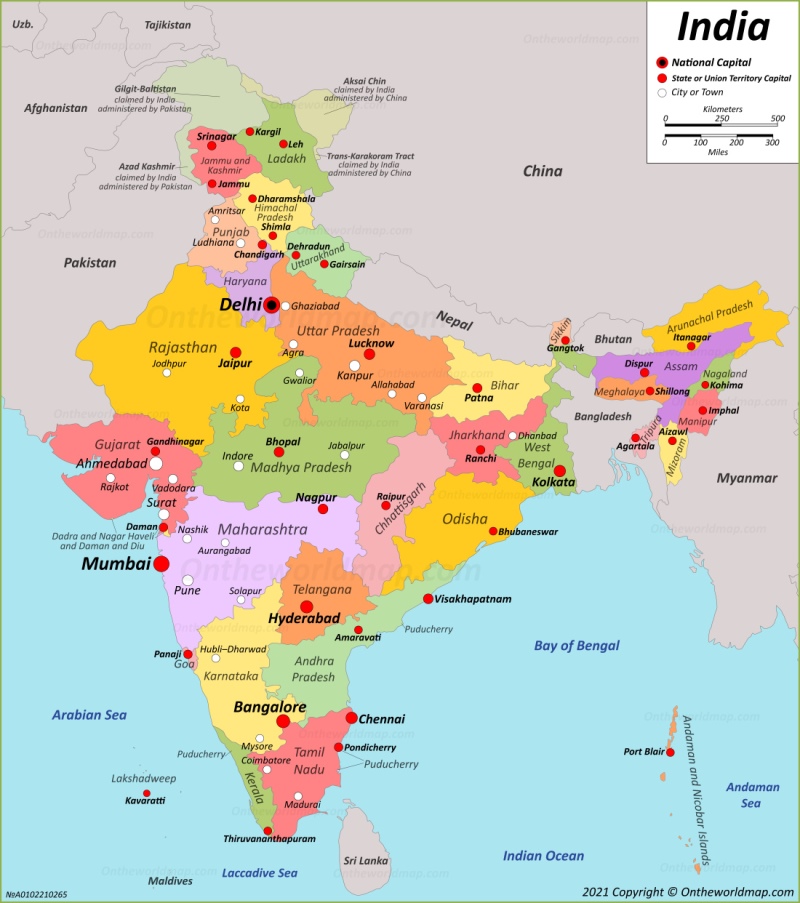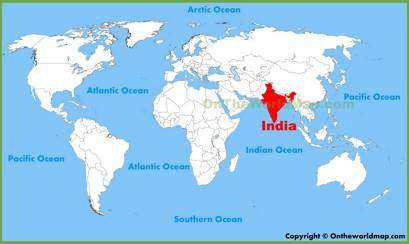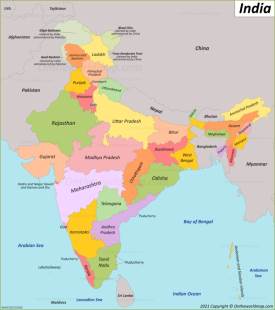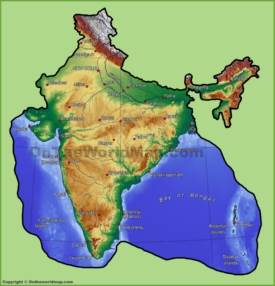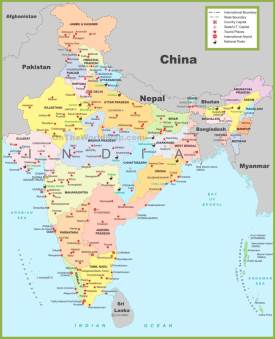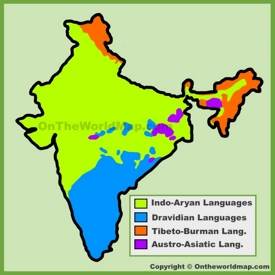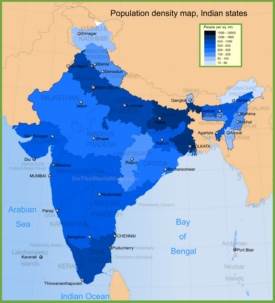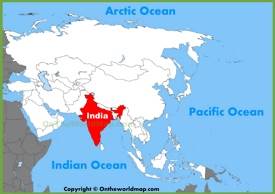India Map
Description:
This map shows governmental boundaries of countries; states, union territories, state capitals and major cities in India.
Image info:
Size: 1400x1581px / 196 Kb
Author: Ontheworldmap.com
You may download, print or use the above map for educational, personal and non-commercial purposes. Attribution is required. For any website, blog, scientific research or e-book, you must place a hyperlink (to this page) with an attribution next to the image used.
Online Map of India
About India
India is a country located in South Asia, ranks as the seventh-largest nation globally by land area and the second in population after China. It shares borders with Pakistan to the northwest, China and Nepal to the north, Bhutan to the northeast, and Bangladesh and Myanmar to the east. In the south, the Indian Ocean surrounds it, providing a lengthy coastline.
New Delhi is the capital city, located in the northern part of the country. Other major urban centers include Mumbai, known for its financial and entertainment industry; Bangalore, acclaimed for its information technology sector; and Kolkata, which has historical and cultural significance.
Tourism plays a vital role in India's economy, with the country offering a diverse range of attractions. The Taj Mahal in Agra, a UNESCO World Heritage Site, stands as a symbol of love and is one of the most recognized globally. Rajasthan attracts visitors with its palaces and forts, depicting India's royal past. Kerala, known as "God's Own Country," provides a picturesque setting with its backwaters and lush green landscapes. Goa is known for its beaches and vibrant nightlife. The Himalayan region appeals to those interested in hiking, mountain climbing, and experiencing serene landscapes.
The Facts:| Flag: |
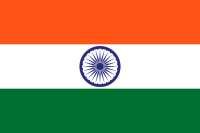
|
| Capital: | New Delhi |
| Area: | 1,269,219 sq mi (3,287,263 sq km) |
| Population: | ~ 1,500,000,000 (2024 estimate) |
| Official language: | Hindi, English |
| Religion: |
|
| Official Spoken Languages: |
|
| Currency: | Indian rupee (₹) (INR) |
| Driving side: | left |
| Calling code: | +91 |
| Internet TLD: | .in |
| Time zone: | UTC+05:30 (IST) |
| Gross domestic product (PPP): |
|
| Gross domestic product (nominal): |
|
| Official government website: | www.india.gov.in |
Google Map of India
List of Largest Cities in India
- Srinagar
- Aurangabad
- Dhanbad
- Amritsar
- Navi Mumbai
- Prayagraj
- Howrah
- Ranchi
- Jabalpur
- Gwalior
- Coimbatore
- Vijayawada
- Jodhpur
- Madurai
- Raipur
Main sights in India
- Taj Mahal
- Jama Masjid
- Sri Harmandir Sahib
- Victoria Memorial
- The City Palace
- Mahabodhi Temple
- Lotus Temple
- Umaid Bhawan Palace
- Brihadeeswara Temple
- Konark Sun Temple
- Amber Palace
- Humayun’s Tomb
- Ellora Caves
- Mysore Palace
- Kanha Tiger Reserve
- Jantar Mantar (Jaipur)
- Hadimba Devi Temple
- Albert Hall Museum
- Agra Fort
- Jaisalmer Fort
- Red Fort
- Mehrangarh Fort
- Chhatrapati Shivaji Maharaj Terminus
- Ajanta Caves
- Nahargarh Fort
- Valley of Flowers National Park
- Shree Siddhivinayak Temple
- Vaishno Devi
- Golconda Fort
- Hawa Mahal
States and Union Territories of India
States of India
| State | Capital | Area | Population (2011) | Official Languages |
|---|---|---|---|---|
| Andhra Pradesh | Amaravati | 62,924 sq mi (162,975 sq km) | 49,600,000 | Telugu |
| Arunachal Pradesh | Itanagar | 32,333 sq mi (83,743 sq km) | 1,400,000 | English |
| Assam | Dispur | 30,285 sq mi (78,438 sq km) | 31,300,000 | Assamese, Boro |
| Bihar | Patna | 36,356 sq mi (94,163 sq km) | 104,100,000 | Hindi |
| Chhattisgarh | Raipur | 52,198 sq mi (135,194 sq km) | 25,600,000 | Hindi |
| Goa | Panaji | 1,429 sq mi (3,702 sq km) | 1,500,000 | Konkani |
| Gujarat | Gandhinagar | 75,685 sq mi (196,024 sq km) | 60,500,000 | Gujarati, Hindi |
| Haryana | Chandigarh | 17,07 sq mi (44,212 sq km) | 25,400,000 | Hindi |
| Himachal Pradesh | Shimla (Summer), Dharamshala (Winter) | 21,495 sq mi (55,673 sq km) | 6,900,000 | Hindi |
| Jharkhand | Ranchi | 30,777 sq mi (79,714 sq km) | 33,000,000 | Hindi |
| Karnataka | Bangalore | 74,05 sq mi (191,791 sq km) | 61,100,000 | Kannada |
| Kerala | Thiruvananthapuram | 15,005 sq mi (38,863 sq km) | 33,500,000 | Malayalam |
| Madhya Pradesh | Bhopal | 119,017 sq mi (308,252 sq km) | 72,700,000 | Hindi |
| Maharashtra | Mumbai (Summer), Nagpur (Winter) | 118,809 sq mi (307,713 sq km) | 112,400,000 | Marathi |
| Manipur | Imphal | 8,620 sq mi (22,327 sq km) | 2,900,000 | Manipuri |
| Meghalaya | Shillong | 8,660 sq mi (22,429 sq km) | 3,000,000 | English |
| Mizoram | Aizawl | 8,139 sq mi (21,081 sq km) | 1,100,000 | Mizo, English, Hindi |
| Nagaland | Kohima | 6,401 sq mi (16,579 sq km) | 2,000,000 | English |
| Odisha | Bhubaneswar | 60,119 sq mi (155,707 sq km) | 42,000,000 | Odia |
| Punjab | Chandigarh | 19,445 sq mi (50,362 sq km) | 27,800,000 | Punjabi |
| Rajasthan | Jaipur | 132,139 sq mi (342,239 sq km) | 68,600,000 | Hindi |
| Sikkim | Gangtok | 2,740 sq mi (7,096 sq km) | 610,000 | Nepali, Sikkimese, Lepcha, English |
| Tamil Nadu | Chennai | 50,216 sq mi (130,058 sq km) | 72,150,000 | Tamil |
| Telangana | Hyderabad | 43,273 sq mi (112,077 sq km) | 35,200,000 | Telugu |
| Tripura | Agartala | 4,051 sq mi (10,491 sq km) | 3,700,000 | Bengali, English, Kokborok |
| Uttar Pradesh | Lucknow | 93,023 sq mi (240,928 sq km) | 199,850,000 | Hindi |
| Uttarakhand | Dehradun (Winter), Bhararisain (Summer) | 20,650 sq mi (53,483 sq km) | 10,100,000 | Hindi |
| West Bengal | Kolkata | 34,267 sq mi (88,752 sq km) | 91,300,000 | Bengali, English |
Union Territories of India
| Union territory | Capital | Area | Population (2011) | Official Languages |
|---|---|---|---|---|
| Andaman and Nicobar Islands | Port Blair | 3,185 sq mi (8,249 sq km) | 380,000 | Hindi, English |
| Chandigarh | Chandigarh | 44 sq mi (114 sq km) | 1,060,000 | English |
| Dadra and Nagar Haveli and Daman and Diu | Daman | 233 sq mi (603 sq km) | 590,000 | Hindi, English |
| Delhi | New Delhi | 573 sq mi (1,484 sq km) | 16,800,000 | Hindi, English |
| Jammu and Kashmir | Srinagar (Summer), Jammu (Winter) | 16,309 sq mi (42,241 sq km) | 12,300,000 | Dogri, English, Hindi, Kashmiri, Urdu |
| Ladakh | Leh (Summer), Kargil (Winter) | 22,836 sq mi (59,146 sq km) | 290,000 | Hindi, English |
| Lakshadweep | Kavaratti | 12 sq mi (32 sq km) | 64,000 | Hindi, English |
| Puducherry | Pondicherry | 185 sq mi (479 sq km) | 1,250,000 | Tamil, French, English |
Geography of India
India, positioned in South Asia, occupies 1.27 million square miles (3.28 million square kilometers), making it the world's seventh-largest country by land area. Its diverse geography ranges from the Himalayan mountain range in the north to the coastal plains along the Indian Ocean to the south. The country's northern borders with Pakistan, China, Nepal, and Bhutan feature rugged terrains and high peaks, including Kanchenjunga, India's highest point at 28,169 ft (8,586 m).
The Ganges, Yamuna, and Brahmaputra rivers, significant for their cultural and spiritual importance, dominate the northern plains, fostering fertile agricultural lands. To the west, the Thar Desert presents arid landscapes, contrasting sharply with the lush Eastern Ghats and Western Ghats mountains that flank the narrow, fertile coastal plains along the eastern and western edges of the Indian peninsula, respectively.
The country's climate ranges from alpine in the Himalayan north to tropical in the southern peninsular region, accommodating a wide variety of ecosystems and biodiversity, including rich forest cover and diverse wildlife. The monsoon significantly influences India's climate, dictating agricultural patterns and water supply.
With over 4,700 miles of coastline, India hosts a variety of ecosystems, including beaches, coral reefs, and mangroves. The strategic location of India's peninsula facilitates significant maritime trade routes. This diverse geographical landscape not only supports a vast array of flora and fauna but also shapes the economic and cultural life of the nation.
Major Rivers of India
- Indus
- Ganges
- Brahmaputra
- Godavari
- Krishna
- Narmada
- Mahanadi
- Kaveri
- Tapti
- Penna
- Mahi
- Baitarani
- Subarnarekha
- Chenab
- Sutlej
- Jhelum
- Ravi
- Yamuna
- Bhima
- Kaveri
- Brahmani
- Sone
- Manjira
- Damodar
- Tungabhadra
- Ponnaiyar
- Ken
- Sabarmati
- Sarayu
- Palar
The Highest Mountains in India
- Kangchenjunga (8,586m / 28,169ft)
- Nanda Devi (7,816m / 25,643ft)
- Kamet (7,756m / 25,446ft)
- Saltoro Kangri / K10 (7,742m / 25,400ft)
- Saser Kangri I / K22 (7,672m / 25,171ft)
- Mamostong Kangri / K35 (7,516m / 24,659ft)
- Saser Kangri II E (7,513m / 24,649ft)
- Saser Kangri III (7,495m / 24,594ft)
- Teram Kangri I (7,462m / 24,482ft)
- Jongsong Peak (7,462m / 24,482ft)
- K12 (7,428m / 24,370ft)
- Kabru N (7,412m / 24,318ft)
- Ghent Kangri (7,401m / 24,281ft)
- Rimo I (7,385m / 24,229ft)
- Teram Kangri III (7,382m / 24,219ft)
- Kirat Chuli (7,362m / 24,153ft)
- Mana Peak (7,272m / 23,858ft)
- Apsarasas Kangri (7,245m / 23,770ft)
- Mukut Parbat (7,242m / 23,760ft)
- Rimo III (7,233m / 23,730ft)
- Singhi Kangri (7,202m / 23,629ft)
- Hardeol (7,161m / 23,494ft)
- Chaukhamba I / Badrinath Peak (7,138m / 23,418ft)
- Nun-Kun (7,135m / 23,408ft)
- Pauhunri (7,128m / 23,385ft)
- Pathibhara / The Pyramid (7,123m / 23,369ft)
- Trisul I (7,120m / 23,359ft)
- Satopanth (7,075m / 23,212ft)
- Tirsuli (7,074m / 23,209ft)
- Chong Kumdang Ri (7,071m / 23,199ft)
Brief History of India
India's history commences with the emergence of the Indus Valley Civilization around 2500 BCE, known for its advanced urban planning and architecture. Following its decline, the Vedic Period introduced foundational elements of Indian culture, including Hinduism. By the 6th century BCE, the region experienced the rise of Jainism and Buddhism, challenging the prevailing social order.
The Maurya Empire (322–185 BCE) unified large parts of the Indian subcontinent under a single administration, highlighted by Ashoka's reign, who later embraced Buddhism. The Gupta Empire (4th–6th centuries CE) succeeded in establishing a classical age, propelling advancements in science, art, and literature.
The medieval period saw the spread of Islam, with the Delhi Sultanate and later the Mughal Empire shaping the subcontinent's political and cultural landscape. The Mughal era peaked with remarkable architectural achievements, including the construction of the Taj Mahal.
European traders arrived in the 16th century, but by the 19th century, the British Crown had assumed control, heralding the colonial era. This period witnessed the rise of a nationalist movement, leading to India's independence in 1947, albeit partitioned with Pakistan.
Post-independence, India embraced democracy and embarked on significant economic and technological advancements, positioning itself as a regional power. It navigates contemporary challenges while preserving its rich heritage, affirming its role on the global stage.

